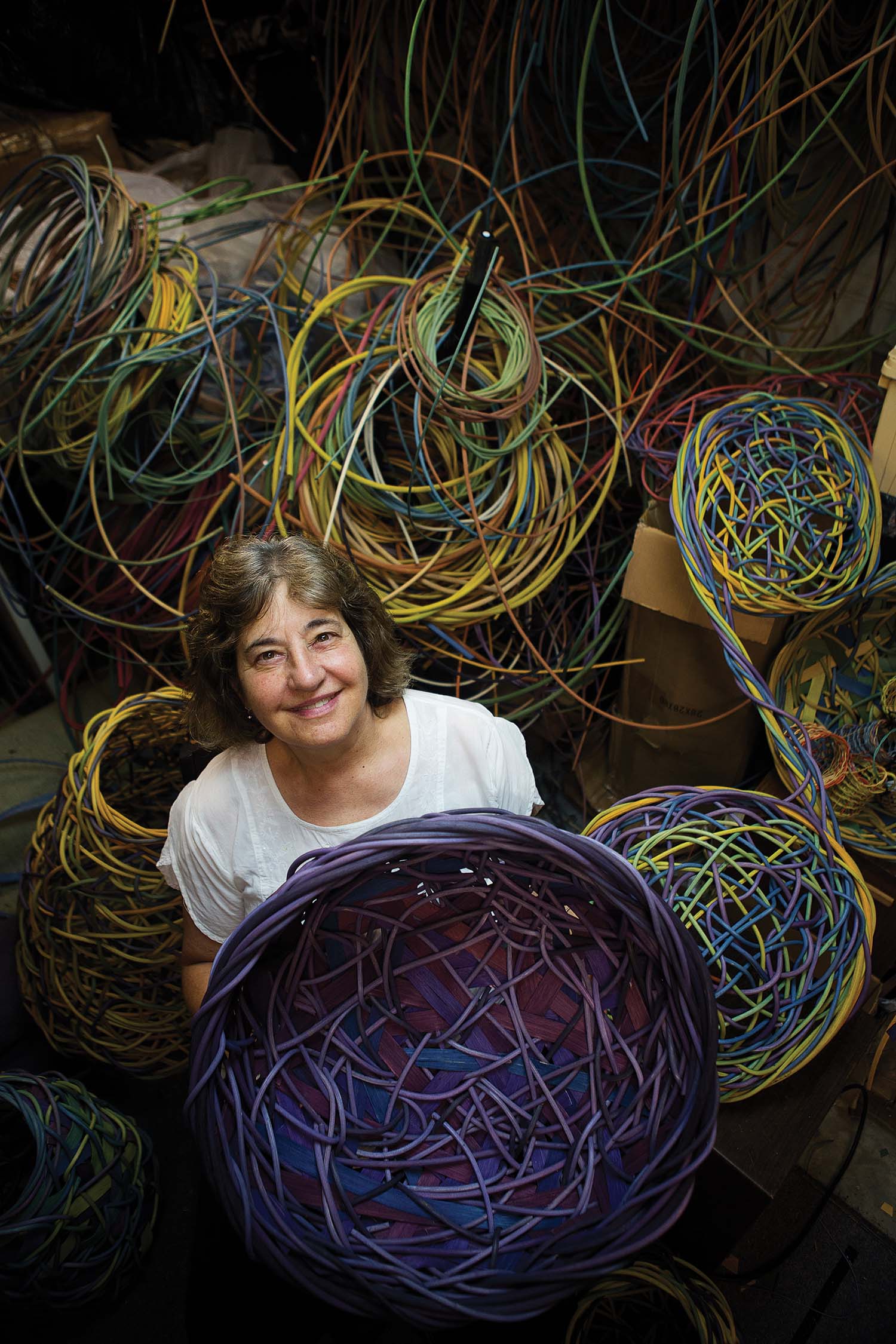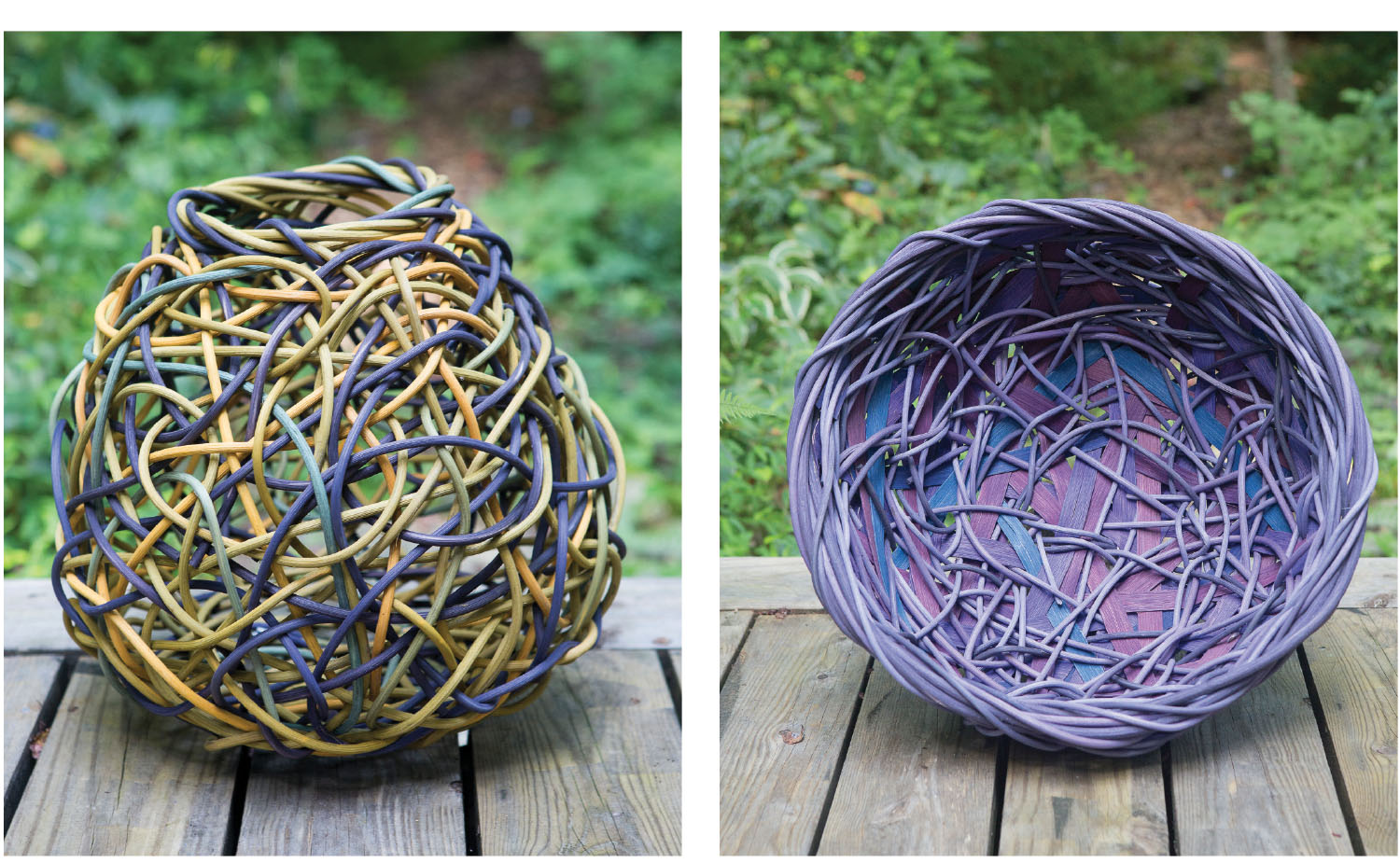
Photo by Matt Rose
Not long after Carla and Greg Filippelli moved to the southern mountains from the Northeast 40 years ago, Greg brought home a damaged woven basket that a neighbor had given him, in hopes it could be repaired. Carla, as most folks knew, had a business creating designer clothing, and might have the skills to patch a basket back together.
That broken-down basket was the unlikely catalyst of a new, shared career. The Filippellis work with native reeds and grasses to produce not only quotidian items like baskets, but also stunning, hand-dyed sculptural forms woven with a technique that’s all their own.
They started with functional wares, “but then we saw a documentary about an indigenous tribe in Borneo,” recalls Carla. “They were nomadic, moving from place to place on almost a daily basis, and we became fascinated with the way they adapted designs taken from the jungle around them to make containers and temporary shelters.” Inspired, the Filippellis gathered vines and reeds from their own property and intuitively constructed a hut, discovering in the process a method they termed “random weave,” which followed no set procedure but was derived from examples in the natural world. Spiders weaving webs, birds making nests, beavers constructing dams — all of them were guides for the couple’s work.
The Filippellis first used their free-form technique for smaller items — such as the baskets that launched their career — but they’ve become known for their larger pieces, commissioned by corporate and private clients and made from native plants including bittersweet vine and ivies (they still collect the wild material on their own). No two pieces are ever the same. All are hand-dyed in palettes chosen with the client. “It’s hands on,” Carla says. “We go and see the surroundings of where the piece is going to be, and take measurements and get a feel for the people who’ll be living with the piece. And we invite them to come to the studio as the work is taking shape.”

In their initial efforts, they used dyes extracted from local plants, but the Filippellis discovered that such dyes weren’t fast, and faded fairly quickly. Chemically based, fiber-reactive dyes that bind permanently with the wood produced longer-lasting results. The look is richly colored and flowing — artworks that seem to have organically formed on their own, mysteriously, without underlying metal or wire framing. In fact, each creation is woven without a set pattern, and thus sets its own path to completion. “It’s a very right-brained process,” says Carla. Their largest work to date is a 26-foot-long wall sculpture commissioned for a private home in Fairview. Other big wall pieces adorn upscale condos in downtown Asheville and in Weaverville. Commissions for public pieces have come from doctors’ offices and hospitals.
The couple’s arrival in Western North Carolina was part of a Whole Earth Catalog-inspired movement in the ’70s — the migration of young seekers escaping establishment strictures for more pastoral settings. “We met a lot of native mountain people when we first moved here [to Ashe County on the North Carolina/Tennessee/Virginia border],” Carla says, “and learned a lot from them about traditional weaving and using whatever you could find in nature for materials.” The couple have lived in Asheville since 1987; they converted a 1946 stone cottage on their property as the heart of their Cranberry Creek Baskets operation, from which a steady stream of work has flowed. The Filippellis have shown work in galleries nationwide, and received international attention as exhibiting artists for the State Department’s Artists in Embassies program in 2005. They also offer workshops and private lessons in their random-weave technique, as well as classes in traditional Appalachian basketry.
A solo show now being prepared opens next year at Winston-Salem’s Piedmont Craftsmen Gallery. “That will make nearly 39 years of weaving,” Carla observes. “We’ve done a lot of growing up together.”

Photos by Matt Rose
Carla and Greg Filippelli, Cranberry Creek Baskets and Sculpture, Asheville. See Cranberry Creek Baskets on Facebook. The Filippellis are members of the Southern Highland Craft Guild. They teach classes and are open for studio visits by appointment: call 828-299-3246 or e-mail cranberryc@bellsouth.net.
